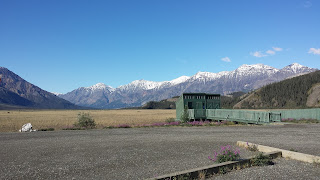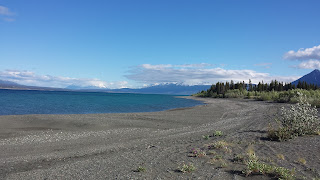 |
| Close up of Kitwanga Totem |
June 8-12, 2016 : Kitwanga, B.C. to Watson Lake, Y.T. 450 miles
Does a bear poop in the woods? Apparently not if the Cassier Highway is close by.
The Cassier Highway runs 450 miles, almost due north through northeastern British Columbia. We had read that bear, both black and brown would be all alongside the highway. Other travelers reported seeing big brown bears and black bear cubs running alongside them. We saw three black bears, and a whole lot of bear poop.
There are few roads to Alaska. Eventually, in fact everyone has to drive the 800 or so miles of the Alaska Highway from Watson Lake , YT and over the U.S. boarder to Tok. Before and after those two towns, however there are a couple of routes. From Prince George there are two options. Go due North and hit the Alaska Highway at Dawson Creek, aka Mile 0, or take the less traveled, route west out of Prince George on the Yellowhead Highway, then turn North on the Cassier Highway.
The Yellowhead Higway is a well traveled, developed route from Prince George to the major port of Prince Rupert. The Cassier, was only just completed in 1972. And it's still kinda rough. Naturally, that is the route we choose. As previously mentioned a hot spot for bears but there are also miles of trees, lakes that are miles long, rivers that run wild, stands of totem poles, masses of mosquitoes, few towns, fewer but lovely camping spots and an awesome side trip to the Pacific Coast with a few glaciers thrown in for dramatic effect.
June 9 : Side trip to Stewart / Hyder
 |
| S.D. on the Seafood Bus |
One of the highlights was the side trip to the town of Stewart, and it's neighboring town of Hyder, U.S.
It was an awesome trip. The day, which was forecasted to be rainy, was actually only partly cloudy and in a good way. There were clouds and there were large patches of blue skies. We were able to see the deep, glowing blue of the glaciers and sometimes the far off snow covered mountains that probably rose all around. Driving West along the Bear River, wildflowers bloomed alongside the road, hanging waterfalls tumbled off every mountainside, and the river roared through the little canyon.
It tooks a little over an hour to arrive in Stewart, B. C. A small town, right at the foot of the Portland Canal/harbor. We stopped at the Visitor Center, had a nice chat with the staff, walked out their boardwalk into the center of the harbor, marveled at the meadow wildflowers and then headed a mile west up the road to the United States and Hyder, Alaska. (No customs or boarder patrol)
 |
| Ice Field of the Salmon Glacier |
...Which was smaller than Stewart, but which also had a Seafood Bus. Finally, our luck was turning. So far on this trip we've been too early for a lot of places. Museums have been closed, campgrounds locked, etc. Today however, we arrived on opening day. The fish and chips with really, really fresh, the halibut was awesome!!!
Continuing down the road, and this is the only road, we turned up alongside the Salmon River, re-entered Canada, bounced over potholes, squeezed over to the side to let giant mining trucks pass, passed an operating gold mine, climbed up a steep rock-strewn, avalanche-prone grade and arrived at the overlook for the Salmon Glacier.
Whoa! Glaciers are awesome!! Having witnessed their after effects for years in New England, and all across the country it was amazing to see one in action. And yes, action is the right word for although they move at a pace of inches per year, still you can see the massive amounts of soil and rocks built up in the side and terminal morans, You can see the marvelous blue jumble that is the ice field and the cracks and striations in the body. Just awesome.
Reversing our drive we headed back. Minus the fish and chips lunch and this time, passing through Canadian customs on the way into Stewart (What he thought we possible could have purchased in store-less Hyder I have no idea), we wound back up the Bear River valley. Just as lovely as it was that morning.























